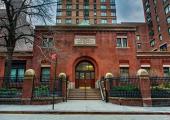Breadcrumbs
Decoding Our World
- Grades 3-4
- Emerging
-
Day
- Science and Engineering
How do we see, perceive, and describe the world around us? We can use mathematics to measure, calculate, and find patterns. We can use technology to expand what we see and observe. And we can tell stories to capture details and create meaning from our experiences. This course sampler gives students an opportunity to explore and describe the world from new and different perspectives.
The sampler will be designed with three cohorts of 3rd and 4th grade students using the following courses as a basis:
Math: Geometry and Spatial Sense
Spatial understanding is necessary for interpreting, understanding, and appreciating our inherently geometric world. Many everyday tasks such as designing a treehouse, solving a jigsaw puzzle, or laying out a garden require spatial reasoning abilities. This course will help students develop those abilities through hands-on investigations and discussions about big ideas as they learn practical and fun ways to apply geometric foundations and spatial sense to the larger world.
In this course, students will learn how to:
- Use coordinates (scale drawing) to develop enlarged images
- Classify and categorize angles and geometric shapes
- Define and calculate perimeter, area, and volume
- Compare geometric objects to determine best fit
- Construct figures using a protractor, compass, and straight edge
Science: Through the Microscope
Today’s 3D microscopes that can capture the nerve connections inside a brain are a far cry from the magnifying lenses ground by hand in the 13th century. Yet both can help us think critically about microscopic worlds. In this course, we’ll learn to identify the parts of a microscope and how they work together to serve as a window into another world. We’ll learn how scientists use microscopes and we’ll record our own observations —such as the color, shape, and features of different cells and multicellular organisms—in a lab notebook. Along the way, students will learn to think and do research like real scientists and gain an introduction to the field of biology.
In this course, students will learn how to:
- Explain how light, refraction, and magnification make a microscope work
- Examine and identify the parts and functionality of a microscope, and calculate magnification
- Use microscopes to make observations and record specific details in a lab notebook, such as the color, shape, and features of different cells and multicellular organisms
- Model scientific techniques for using microscopes as a tool to investigate cell responses to changes in the cell’s environment
Writing: Being a Reader, Becoming a Writer
How do writers effectively capture the people and places they observe? In this course, we’ll read pieces of fiction and nonfiction and begin to explore the elements of good storytelling. Students will learn to provide details that develop character and a sense of place, and to think inwardly as they write a short story or personal narrative based on people and places they know.
In this course, students will learn how to:
- Keep a writer’s journal
- Create a story using the writing process
- Explain the basic elements of narrative writing
- Understand and apply the concept “show, don’t tell”
- Illustrate and apply elements of character development
- Apply various writing techniques for creating a setting of a story
- Explain the importance of the use of the five senses and realistic details in a story
- Provide constructive feedback to peers in a writers’ workshop setting
This course is
ungraded.
Summer Dates & Locations
Session One
Session Two
Testing and Prerequisites
| Math | Verbal | |
|---|---|---|
| Required Level | Not required | Not required |
Students must achieve qualifying scores on an advanced assessment to be eligible for CTY programs. If you don’t have qualifying scores, you have several different testing options. We’ll help you find the right option for your situation.
Sign up for Testing Learn MoreCost and Financial Aid
Tuition
- Varies
Application fee
- Nonrefundable Application Fee - $55 (Waived for financial aid applicants)
- Nonrefundable International Fee - $250 (outside US only)
We have concluded our financial aid application review process for 2025 On-Campus Programs. We encourage those who may need assistance in the future to apply for aid as early as possible. We are committed to serving all talented youth regardless of financial circumstances. Financial assistance is available based on need.
Course Materials
Students should bring basic school supplies like pens, notebooks, and folders to their summer program. You will be notified of any additional items needed before the course begins. All other materials will be provided by CTY.
Course Extras (Lab fee info, etc)
Lab fee: $60


